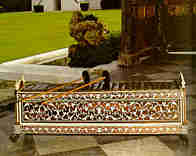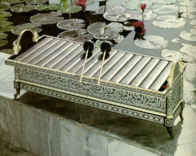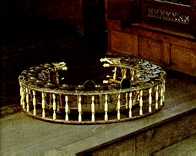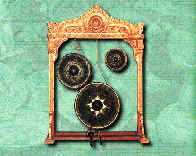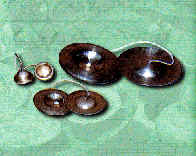|
Ranad Ek Lek This instrument has metal keys and actually ought to be listed in the section on the metal instruments, but, because it is built and played in a similar manner to the wooden ranad, it is discussed in this section. This instrument was
originated in the reign of King Rama IV (1854-1868). At first the keys were made of brass
and the instrument was called ranad thawng. Later, the keys were made also of iron
or an alloy, but in both cases the keys closely resemble those of the ranad ek and
have the same pitches, so the instrument was called ranad ek lek. |
|
Ranad Thum Lek The idea for this instrument is attributed to the brother of King Rama IV(1854-1868), who was known during that reign as the "second king." He thought of making another instrument in the same style as the preceding, but lower in tone, somewhat as in the West the accordion is a larger model of the principle used in the mouth organ. The keys are made in the same shape as in the ranad ek lek but are larger, thus giving deeper tones comparable to the ranad thum. |
|
Khawng Wong Yai The “circle of gongs” is a further development of the single gong. The circular stand for the series of gongs is a framework made of a type of large, round rattan. It is placed on the floor and is 24 cm. The large inner and outer pieces of rattan, between which the gongs are suspended, are 20 cm. apart on the end which contains the low-toned gongs, ranging gradually closer together until they are 17.5 cm. apart on the end which contains the high-toned gongs. The framework is almost a complete circle or oval, inside of which the player sits. |
|
Khawng Wong Lek It appears that the khawng wong lek was devised during the reign of King Rama III (1824-1854) by skilled musicians. They decided to make an instrument like the khawng wong, in exact detail, except smaller. This instrument is also used in the piphat ensemble together with the larger model. The new, smaller model was named khawng lek “small circle of gongs.” |
|
Khawng Mawn There is another type of khawng wong, called the khawng mawn, which is used in certain musical ensembles. The gongs are in the row as khawng wong yai, but the framework is of a crescent shape with the ends extending upward rather than in a circular shape with the floor or ground. The stand is of heavy wood, hollowed out on the inside ad beautifully carved and decorated with gold paint and bits of colored glass and mirrors on the outside. One end of the crescent is carved to represent the head of a mythical creature, half bird-half human. This instrument
usually has 15 gongs. The khawng mawn is used in the ensemble called piphat
raman or piphat mawn. When the khawng wong lek was devised, another khawng
mawn was also constructed, and the two khawng mawn were differentiated by
calling the larger one the khawng mawn yai and the smaller one the khawng mawn
lek. |
|
Khawng Mong Thai musical ensembles
use several sizes of gongs or khawng. The kind which has a diameter of from 30-45
cm., when beaten, gives the sound mong, and this sound is used for the name—khawng
mong or simply mong. The Thai have had gongs as well as drums in their musical
ensembles for a very long time; in fact, in both the spoken and written language, they are
often mentioned together as “ khawng glawng." In the old days and
until the advent of mechanical methods, these two instruments were used to announce the
time of day and night—the gong for the daylight hours and the drum for the night
hours. The drum gave the sound thum, and the night hours became known as thum.
The gong was used for the daylight hours. These two words are in use at the present day. |
|
Ching & Chab The ching is a percussion instrument of the cymbal type. It consists of a pair of cymbals, each of which is made of thick metal, shaped like a teacup or like a small hollow cone. The two ching are played by hitting them together. Each one measures from 6-7 cm in diameter across the open side. At the apex of each there is small hole through which a cord is passed. A knot at each end of the cord fits inside the apex of each cymbal and prevents the cord from pulling though. The cord is continuous, fastening the two cymbals together, and is for convenience in holding them in playing position. |
